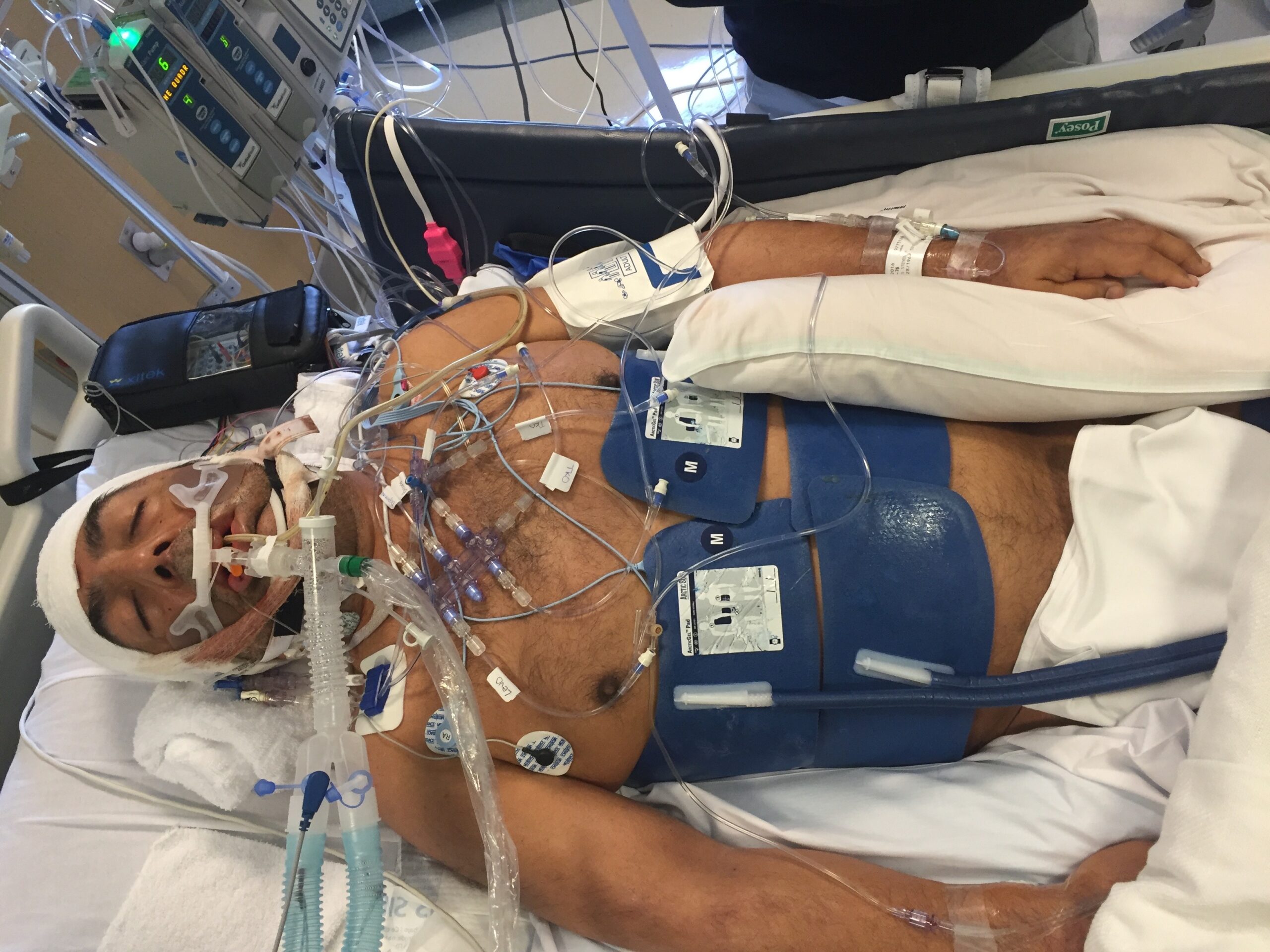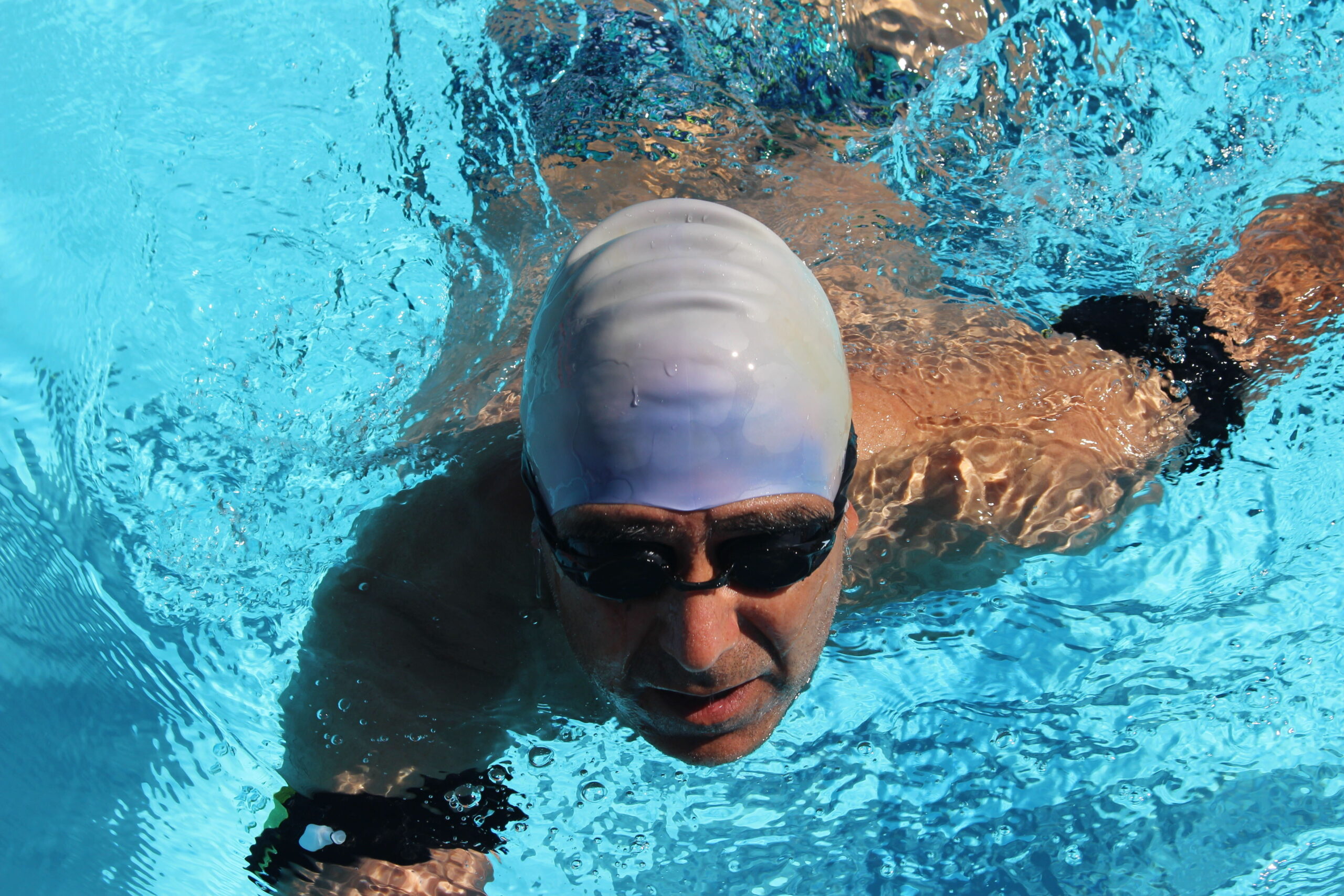A lifelong long-distance swimmer in great shape, he suffered a nearly fatal heart attack out of the blue. He survived only because his 17-year-old son was able to perform CPR on him until the paramedics arrived. Widow-maker heart attacks can happen to the most athletic of us with no warning. This is one more reason to value and enjoy each day we have.
For Steven Munatones, recovery included getting back to swimming and to using a novel Japanese recovery modality known as Kaatsu. In a remarkably short time he was back in the water, and recently completed, and even won, SCAR, a 37.4-mile race in Arizona where marathon swimmers from around the world come to test themselves, swimming across 4 lakes on 4 consecutive days. The event is all done in open cold water and, for even those highly trained, it can be a crushing experience, let alone someone 61 and just coming off a near-fatal cardiac event. We can truly do remarkable things, far beyond what others may expect of us.
His motto is: Be Good, Do Good, Choose Good, which sounds like a pretty good roadmap for living well. We discussed his journey to health, and what was for me the counterintuitive way in which Kaatsu works.

Where do you live?
Huntington Beach, California.
Tell us about the heart attack. You were an athlete — do you have any thoughts on what caused it?
Being fit helped me survive the widowmaker heart attack. The last thing that I remember was a family dinner on a Sunday; 9 days later, I woke up in a hospital with tubes in me and monitors on me. The underlying cause was a chronic lack of sleep that created low-grade stress over decades, leading to inflammation in my arteries. The final catalyst for my heart stopping and a clot in my left ascending artery was an 11-day period when I traveled to and from Japan 3 times, in economy class, while barely sleeping. Coming off the airplane on the last leg, my peripheral vision narrowed. I had a meal with my family, but I do not remember anything until I woke up in a hospital bed.
“Being fit helped me survive the widowmaker heart attack”
Your son performed CPR to save your life. Was he trained in it? How old was he when this happened?
My son, a 17-year-old high school senior, was not trained in CPR. It was his first time to perform hands-only CPR, but the 911 operator talked him through it. He was calm and did well enough to keep me alive for some time. After the stent was placed in my left anterior descending artery, my cardiologist told my wife that I was likely to suffer severe neurological damage. Fortunately, my son prevented that level of damage, but an EEG test was conducted on me for a research project 5 years later. They found certain parts of my brain are no longer active — but I guess I do not miss those inactive parts.
How did the heart attack change your thoughts on your life and what you wanted to do?
Because my son, paramedics, CCU and ICU nurses, and doctors enabled me to escape death, I forever changed in 3 fundamental ways. Firstly, I am very thankful when I wake up each morning. Each day is a gift that I cherish — and no longer take for granted. Secondly, I changed my perspective to focus on the immediate; that has helped me become more focused in my own actions and to be much more appreciative of those around me. Thirdly, this second chance at life has motivated me to listen more carefully, observe more closely, and share more deeply with others.

Was there a recovery process you went through after it?
When I awoke (from the Arctic Sun protocol — see attached photos), different cardiologists told me to do certain things. But I saw value in two things: swimming and Kaatsu. Both are gentle, simple actions that I can do daily. But all of that did not matter, if I didn’t learn how to sleep better. So naps became a critical part of my recovery.
“I gradually built up from swimming 30-45 minutes per day to swimming an average of over 6 miles per day, 7 days per week”
You went to win SCAR last year. What is that race and how did you prepare?
It is a 37.4-mile race in Arizona where marathon swimmers from around the world come to test themselves, swimming across 4 lakes on 4 consecutive days: 13 km on Day 1 + 14 km on Day 2 + 23 km on Day 3 + 10 km on Day 4. SCAR is an acronym for the four lakes: Saguaro + Canyon + Apache + Roosevelt. It is set in a stunning location and presents a physiological, psychological, and logistical challenge. I did it to prove to myself that I recovered from my heart attack 6 years earlier. Additionally, I had not competed in nearly 40 years. I gradually built up from swimming 30-45 minutes per day to swimming an average of over 6 miles per day, 7 days per week. Whether in the ocean or the pool, I was going for it. My goal was to get to a point where I could swim at a pace of 1 minute 20 seconds per 100 meters for hours. That was a pace that I was capable of in my 20s. It was very satisfying to return to that kind of strength and stamina, whether or not I finished or won the race.
You are a lifelong swimmer. During the time you were living in Japan, were you also doing open-water swims and what were they like?
Yes, I did 5 unprecedented marathon swims while I lived 7 years in Japan. It was a perfect way for me to travel the country from one end to the other while interacting with many Japanese people along the way. I swam 42 km across Lake Biwa, the biggest lake in Japan. After that, I swam across the Five Lakes of Mount Fuji in one day and then climbed up Mt. Fuji the following day. Then, I swam back and forth between the main Japanese island of Honshu and its northernmost island of Hokkaido where there is plenty of marine life. I swam around Yonaguni Island, the westernmost island of Japan, where I saw hundreds of hammerhead sharks circling below me. Later on, I did another swim between 3 islands in Okinawa where there were many reef sharks. Each one of these was quite a special and different experience.

“In the ocean, it is my personal way to face uncertainty, experience drama, and explore pushing my limits”
What is it about long open-water swims that you like?
The sense of adventure and the very real possibility of failure. I enjoy doing marathon swims that have never been attempted before. These swims require years of research, planning, and preparation to safely deal with water temperatures (both warm and cold), conditions, currents, and marine life. 100, 200, 500, 1000 years ago, people faced all kinds of challenges and experiences in the course of their lives. Nowadays, we live in climate-controlled dwellings, we can drive or fly to many places, food is at our fingertips, GPS tells us where we are all the time. Our safe and sedentary lives lack drama. But in the ocean, especially in places where people have never yet swum, it is my personal way to face uncertainty, experience drama, and explore pushing my limits.
These are very long swims. How do you mentally stay focused during them?
In unprecedented swims — and in training — it is easy to stay focused. Because there is so much that I want to do, on dry land I think about everything that needs to get done that day or in the future. When I swim in the ocean, I cannot hear much, see very far, or talk to people. This makes it a thoroughly introspective cerebral activity. Because the physical act of swimming is second nature to me, I am constantly thinking about many things. In the water, I think as freely and as deeply as I can. I try to keep my thoughts organized, but I often find myself forgetting details or addressing an issue from a different angle.
You have written a book on open swimming which is a sport that seems to be becoming increasingly popular with people. What are some tips you could share on it?
Always swim in safe locations and conditions. Swim along the shoreline. Anticipate what can possibly go wrong and how you should react in those situations. Simply enjoy the physical exercise, sense of adventure, and rugged aquatic beauty of Mother Nature.
Tell us about your college swimming.
I swam butterfly and played water polo for 4 years in college — while co-owning an on-campus restaurant called The Holy Grille — and did open-water swimming in the summers, representing the US. Doing 3 different aquatic disciplines required training 12 months a year in addition to work and studies. I enjoyed it, but I was always running out of one thing: time.
Are your kids swimmers?
Three of my four children play or played water polo in college. The oldest one played volleyball.

Kaatsu
You are also the CEO of Kaatsu. We understand you are working with wounded veterans groups. Please tell us about that.
Kaatsu helps those who are bedridden, disabled, recovering from surgery or illnesses, and amputees by keeping their vascular tissue elastic (i.e., improving their blood circulation), and helping them avoid muscle atrophy. The anecdotal response from 90% of the wounded warriors we work with is positive. They say it also results in reduction of neuropathic pain and residual limb discomfort, and a significant decrease in spasticity. This is why many veterans enjoy and benefit from Kaatsu. We work with the Navy SEAL Foundation, Operation Healing Forces, and the Wounded Warrior Project, among others.
Kaatsu is something that initially I found rather counterintuitive, with its focus on gentleness rather than the ‘no pain no gain’ mentality we Westerners often have, yet it is widely successfully used in Japan. Help us out here. If someone were to just use Kaatsu daily, and make no other changes to their routine, what changes would they expect to see after 6 months?
There are two primary benefits: (1) improving the elasticity of vascular tissue which helps blood circulation by increasing vasodilators (nitric oxide and vascular endothelial cells), and (2) generating a regular, robust hormonal response that, depending on what you normally do (e.g., walking, stretching, yoga, strength training or cycling) improves muscle tone, increases functional strength, enhances recovery, or increases stamina. Simply: users can see improved muscle tone and blood circulation by adding Kaatsu Cycle sets to their existing daily routine.

We have heard that the big customer base for Kaatsu is the Japanese “face gyms,” which we didn’t really understand. What are they using it for and have you tested out if it works?
Kaatsu Beauty is among the most popular protocols with female users. There are many capillaries in and under our skin. Kaatsu Beauty uses the Progressive Cycle mode with AirBands on your arms while doing gentle upper body movement. These movements include head rotations, stretching your upper body, and repeatedly saying the vowels in an exaggerated manner (a-e-i-o-u). It is important to be well hydrated before and during a Kaatsu Beauty session. Some experienced specialists spritz their face with rose water and moisturize their skin with specialty ointments right before starting Kaatsu. This facial and upper body work can be enhanced with casual Kaatsu Walking or some kind of easy calisthenics. Think: yoga, or stretching of the lower body.
What music are you listening to?
Currently, I like music by Hans Zimmer because it helps me stay focused. It also seems to stimulate me with energy and creativity.
What books have you read recently that you enjoyed?
I am inspired by books by explorers and adventurers, both living and deceased. This recently includes Sir Ernest Shackleton, the Antarctic explorer who lived over 100 years ago, Lewis Pugh, OIG, the current United Nations Patron of the Oceans, and Ram Barkai, founder of the International Ice Swimming Association.
What are the 3 non-negotiables in your life?
I try to live up to the motto Be Good, Do Good, Choose Good. In practical terms, I write and exercise daily. I never miss my children’s games or competitions. And, most importantly, I follow my wife’s advice and guidance.
Main image by David Harry Stewart.
Connect with Steven:
LinkedIn
Kaatsu — Use code “AGEIST” at checkout for a discount
Open Water Swimming book
LEAVE A REPLY
The ideas expressed here are solely the opinions of the author and are not researched or verified by AGEIST LLC, or anyone associated with AGEIST LLC. This material should not be construed as medical advice or recommendation, it is for informational use only. We encourage all readers to discuss with your qualified practitioners the relevance of the application of any of these ideas to your life. The recommendations contained herein are not intended to diagnose, treat, cure or prevent any disease. You should always consult your physician or other qualified health provider before starting any new treatment or stopping any treatment that has been prescribed for you by your physician or other qualified health provider. Please call your doctor or 911 immediately if you think you may have a medical or psychiatric emergency.



Wonderful article. Highly inspirational. I will now go and look up Kaatsu.
This is a great article about à very fantastic person. I did not Knowles all of rhis about Steven and thank you bécasse this makes me admire him éventuellement more.
Great article. Steven is inspirational and has done so much for open water swimmers and swimming around the world.
What a wonderful and inspiring story. It was so much fun to see Steve at USA Swimming Golden Goggles celebration recently in LA. We traveled the world together with international Open Water events for years.
I met Steve October, 2023 while in Kona, HI. My conversations with him that week were so inspirational about swimming, KAATSU, his recovery from a heart attack, and life. It was never a dull moment. Can’t wait to read your OWS book Steve, and hope to see you soon!